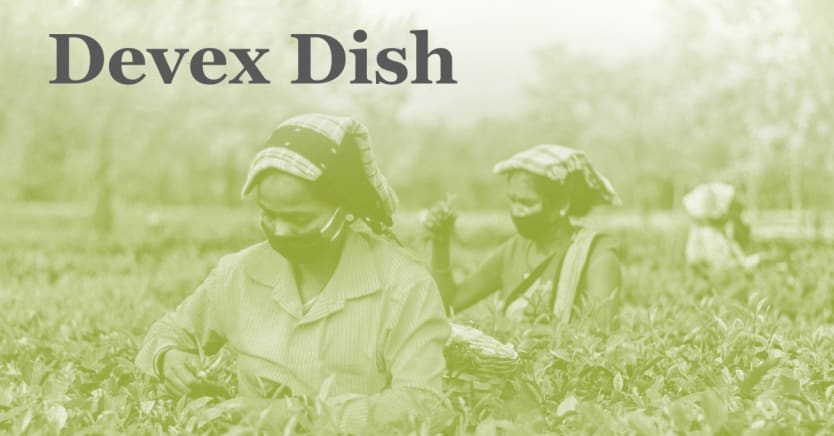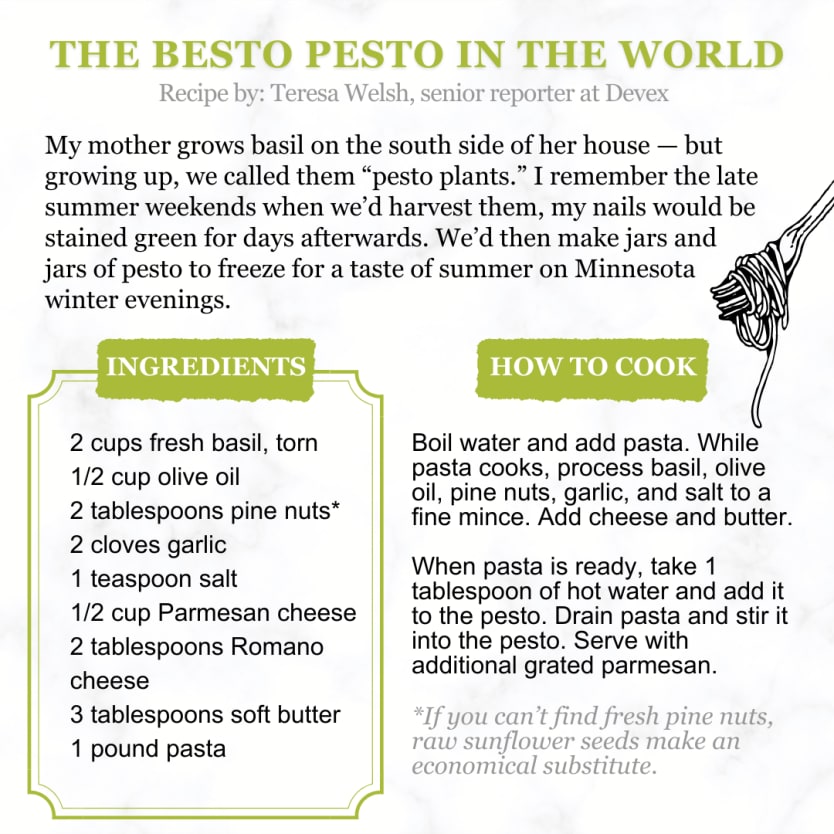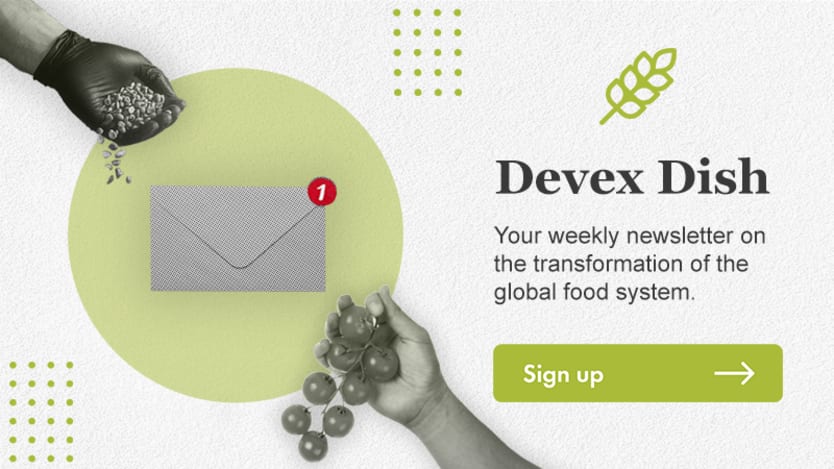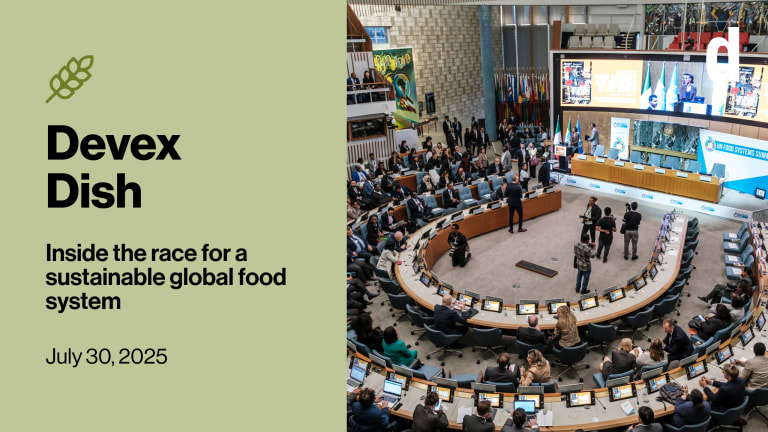
Today is International Day of Awareness of Food Loss and Waste, and I challenge you to not let that final bit of wilting produce you meant to use last week go to waste. If that happens to be a batch of basil, scroll down for a suggestion of how to use it up.
This is a preview of Devex Dish
Sign up to this newsletter to get the inside track on how agriculture, nutrition, sustainability, and more are intersecting to remake the global food system in this weekly newsletter.
Last week was a big one for food systems on the global stage, with the long-awaited U.N. Food Systems Summit, as well as the alternative Global People’s Summit on Food Systems taking place in a mix of virtual and in-person formats.
Participants of the UNFSS repeated a mantra emphasizing the urgency of the task at hand, making the case for food systems reform with “only nine harvests left” until 2030, the deadline to meet the Sustainable Development Goals. Nearly every SDG touches on an aspect of the food system, making achieving the global goals impossible if food systems transformation does not take place.
The UNFSS saw a pledge from the U.S. of $10 billion over five years “to end hunger and invest in the food system,” while the Gates Foundation made its largest ever contribution to nutrition, with a pledge of $922 million over five years.
While I was in New York, my colleague Rumbi Chakamba was following the Global People’s Summit, an alternative event coordinated by those who didn’t see a place for themselves in the official U.N. summit.
Rumbi tells me that organizers of the Global People’s Summit dismissed UNFSS commitments, alleging that they “promote industrial monocultures over agro-ecological food.” The group’s declaration released after the event goes on:
“We believe that an equitable food system can only be built on the people's right to land and livelihoods, and to decent working and living conditions for all. This means that food production must be decided by the sovereign will of the people, based on their particular circumstances, priorities, and needs. Profit motives of corporations — euphemistically called market forces — should not determine what food to produce, how to produce it, and for whom.”
For Devex Pro subscribers, Rumbi dives into more detail on takeaways from the two events, and why some civil society members felt engaging with the U.N. process was their best, if not perfect, option for change.
As always, I’m eager to hear your impressions of both summits, and more importantly, what must happen now before those nine harvests turn to eight. Write to me with your thoughts at dish@devex.com.
Devex Pro: Did the UN Food Summit provide solutions for marginalized groups?
From the Pro archives: Wasted food means wasting time to meet SDGs, researchers say
A mouthful
“My father and mother live in Lebanon. They are what people call small producers. They have an apple orchard in our village in the mountains ... And they're struggling through financial instability, they’re struggling with the pandemic … If they ask me what this summit was and how it would help them right now, I have no answer.”
— Michael Fakhri, who is the U.N. special rapporteur on the right to food and has been critical of the UNFSS, told me in an interview last week after the event.Fakhri wants to see the Committee on World Food Security take the lead on carrying summit work forward because the organization already has strong civil society participation. CFS meets next month, and I’ll be watching to see if and how it takes up where the summit left off.
Watch this space
You’ve heard me talk a lot about accountability in the lead up to the summit, and last week brought a glimpse into one mechanism that aims to help lay benchmarks and measure progress for food systems reform. Jess Fanzo of Johns Hopkins University, working with the Global Alliance for Improved Nutrition, is leading the team of researchers known as the Food Systems Monitoring Project.
“We are proposing to develop and implement a rigorous, science-based monitoring framework to assess the state of food systems,” Fanzo said last week during a virtual event detailing the project. “You can use this to determine whether they are on or off track.”
The project focuses on five thematic areas, and the work the group has done so far will be published next month in Food Policy. Stay tuned for more.
Know about another accountability mechanism in the wake of the UNFSS? Let me know at dish@devex.com.
Number munching
“25%”
—The percentage of the world’s food that comes from cropland irrigated by river water, according to the World Wildlife Fund. My colleague Rebecca Root digs into why support for rivers is running dry.
Today’s dish

Basil — along with eggplants, zucchini and other produce — is now being grown in a taxicab parking lot in Bangkok, where the cab cooperative is trying to help feed people by farming vegetables on the roofs of cars left idle during harsh COVID-19 lockdown restrictions.
Two birds, one seed
In 2007, nonprofit agricultural research institution International Crops Research Institute for the Semi-Arid Tropics realized that African farmers had — for decades — been planting traditional varieties of seeds that could not cope with the challenges of climate change. National governments also lacked the capacity to help farmers develop seed varieties that would increase crop yields enough to allow them to sell products in the market.
By 2019, the institute had developed 266 improved legume varieties and produced nearly a million tons of seeds developed for farmers in 13 African countries. This year, ICRISAT was awarded the Africa Food Prize in recognition of its work on developing seed varieties that could not only help increase yield, but also resist drought, pests, and diseases.
Today’s list: Rumbi has the info on the six African food security experts to watch.
Take a bite
Animal-based foods account for 57% of global food production’s greenhouse gas emissions, while plant-based ones make up 29%. [Scientific American]
Because of labor demand and perishability, fruit and vegetable loss percentages are highest in sub-Saharan Africa — between 15% to 50%. [Food and Agriculture Organization]
Only 26 of the world’s 350 largest food and agriculture companies are working to reduce greenhouse gas emissions in line with the Paris Agreement. [World Benchmarking Alliance]









